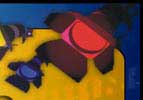 Heritage Community Foundation Presents
Heritage Community Foundation PresentsAlberta Online Encyclopedia
 |
 |
 |
|||
     |
Legacy Article "Art Banking"
Over the past year, in addition to the five 25th Anniversary Exhibitions, 11 smaller shows with works from the collection have toured the province. Coordinated through four public galleries across the province, the AFA's popular Traveling Exhibition Program reaches hundreds of thousands of Albertans, especially school audiences. Thousands of other works from the collection hang in public offices across the province for Albertans to enjoy every day. To stay vital and reflect visual arts activities in Alberta, the collection must continue to grow. Primarily, it acquires new work through the semi-annual Slide Submission Projects. It invites artists not represented in the collection to apply in April, while in September, all artists have a chance to have up to five works considered for addition to the collection. A panel of three visual arts professionals judges all submissions, during four days of deliberation.
Among the most recent acquisitions, the predominant subject is the landscape. In Alberta, because of the diverse terrain and the impact the land has on people, the landscape has greatly influenced the direction of art making. As the jury pointed out, much of the new work in the collection is about a sense of place. Certainly the work of retired miner Charlie Miller from Hinton addresses the rigours of rural Alberta life. His painting, Terror and Tranquility, records the power and destruction of the forest fires so common in summertime Alberta. The work of Michael Cameron, a new artist to the collection, addresses the same theme. His lush "new romantic" approach to painting captures the energy of this natural force, even in the miniature scale of 12-17-96. However, wilderness is not the only landscape. Much of the photographic work selected reflects the influence of both rural and urban environments. Paul Murasko's Georgia Baths continues this Edmonton artist's, ongoing exploration of the city. The slightly seedy nature of the subject matter and strident colour choices tend to contradict the nostalgic first impression his hand-tinting technique gives the work.
Not all of the new work is a literal interpretation of contemporary Alberta. Some represent the international trend to explore pop-culture icons. For example, in Nature's Way is a Complicated Succession of Curve within Curve, Denise Beauregard of Edmonton raises images of a cartoon character to fine art by incorporating them in a large-scale relief. The new acquisitions also included major pieces of sculpture. Among them, Calgary's Blake Senini removes architectural details from their original context and presents them as art objects. The new acquisitions provide a glimpse of studio activity across the province. Each work speaks to the concerns of the artists and their response to their world. Together, they make up a rich legacy for Albertans to enjoy for generations. Ross Bradley is Arts Development Consultant, Visual and Media Arts for the Arts and Libraries Branch, Alberta Community Development. |
|
|||
|
|
|||||
|
Copyright © 2003 Heritage Community Foundation All Rights Reserved |
|||||
 |
 |
 |
For more on Alberta's Arts Heritage, visit Peel’s Prairie Provinces.





